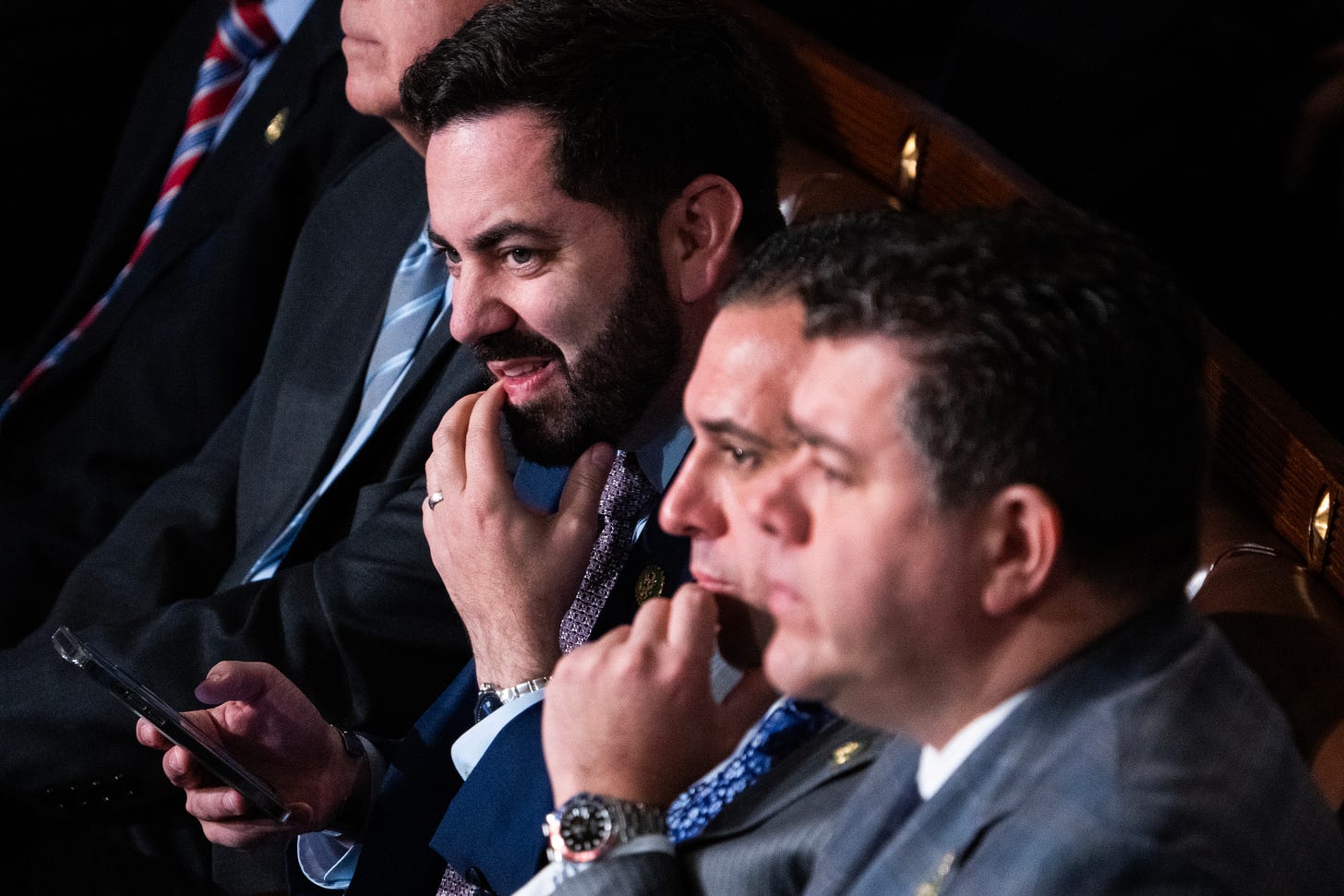Dueling Discharge Petitions Give “Moderate” Republicans an Easy Out
Plus: A history lesson about public space.
By now, you are probably familiar with the basics of discharge petitions, including how unrealistic and unsuccessful they often are. As I’ve said before, they are better used as a pressure mechanism for a House leadership who want to avoid shame and embarrassment than as a tool for directly passing legislation. But in order for the pressure mechanism to work, two conditions must be met: (1) the speaker of the House needs to be capable of feeling genuine shame, and (2) the discharge petition in question needs to carry at least the possibility of getting the necessary 218 signatures.
Given those conditions, it’s starting to look unlikely that the aid will be released this way. For one, it’s still not clear whether the former is true. But there’s a problem on the latter score, too, thanks to two competing discharge petitions.
Here’s the breakdown between them:
The McGovern petition: Rep. James McGovern (D-Mass.) brought forward a discharge petition to force a vote on the standalone $95 billion foreign aid supplemental package that already sailed through the Senate 70–29. This does not include a border-security component or give any concessions or sweet kickbacks. It is just an aid package for Israel, Taiwan, and Ukraine.
The Fitzpatrick petition: Rep. Brian Fitzpatrick (R-Pa.) has a discharge petition to force a vote on a combination bill that includes new border security and immigration restrictions and a foreign aid package to the same three countries but in a smaller amount of around $66 billion.
(If you clicked through and were confused to see that these petitions appear to be advancing unrelated bills about things like “mandatory livestock reporting extensions” and reducing earthquake hazards, it’s because these have been made into content-agnostic shell bills to help the discharge petitions move more quickly to a vote; the finer points of the proposed legislation will be filled in later. This kind of repurposing happens all the time, especially for last-minute items: One of the recent continuing resolutions technically passed as an update to the Permanent Electronic Duck Stamp Act of 2013.)
Right now, the two discharge petitions are in limbo because the foreign aid–only one offered by McGovern has 177 signatures, all of whom are Democrats, while the Fitzpatrick petition has just 14 signatures (eight Republicans and six Democrats). With the exception of Rep. Jared Golden (D-Maine), all the Democrats who signed the Fitzpatrick petition have also signed the McGovern petition. Zero Republicans have signed the McGovern petition.
It’s no surprise that many of the signatories on the Fitzpatrick petition are Republicans who won their seats in Biden-winning districts, including Reps. Mike Lawler, Anthony D’Esposito, and Nick LaLota, who are all from New York.
The reason the bipartisan Senate compromise on border security didn’t work is because so many Republicans want to be able to campaign on the issue for November’s election, which they hope will magically produce a trifecta government, including a Senate supermajority—all of which will be necessary to enact the hard-right legislation they actually want. Recall that, back in December, hours after the compromise bill came out, it went down after catching multiple torpedoes from former President Donald Trump and the perpetually dissatisfied conservative base that takes its political cues from him.
This context makes it tough to be hopeful about the prospects for any foreign aid package going through before next year, especially given the decisions Republicans are making about which petition to sign. You have to wonder why the so-called “moderate” House Republicans who want to see a foreign aid package advance (most urgently for Ukraine) are going along with Fitzpatrick’s proposal, which has no shot of passing either chamber, instead of McGovern’s, which has already passed the Senate with a margin that puts it beyond the reach of a filibuster. Maybe it’s just about appearing to be moderate.
Alternative architectural history
I’ve been a subscriber to Thrasher, the leading magazine for all things skateboarding, since I was a kid. Unlike a lot of print publications, Thrasher still lands on my doorstep with a lot of heft: It’s still as thick as the Iliad every month, which is one of the benefits of being the only major magazine in town with millions of dedicated readers and an entire industry eager to advertise through brilliant artwork and photography. But their YouTube channel is also a behemoth, and it produces original series that are for the most part strictly about skateboarding.
However, there is a new series, just into its second season, that I think could appeal to people who know nothing about skateboarding or who are interested primarily in history. Each episode of This Old Ledge unpacks the origins of a bit of mundane architecture—a ledge, stairset, handrail, or plaza—that everyone who lives in a place would recognize, but only the skaters in that city actually use in a conscious and creative way.
The first season of This Old Ledge focused on the San Francisco Bay Area, and it featured many of the spots I skated while in high school, like the Embarcadero and Pier 7. The most recent episode takes us to the New York State Supreme Court Building and the large sloped banks on the sides of its front steps. If you’ve walked by, you’ve no doubt seen skaters falling off of or maybe stomping a trick on those banks.
This iconic skate spot actually has a long and rich history that goes back to the old Manhattan memorably depicted in Gangs of New York, and its construction connects to what was once one of the most dangerous neighborhoods in America. The whole episode is worth a watch. Check it out here.






The moderate GOP and I have different definitions of the term moderate. They are, at best, MAGA-lite.
Re: This Old Ledge WOW: I know nothing about skateboarding and I'm too old to start, but that was fascinating! Thank you.